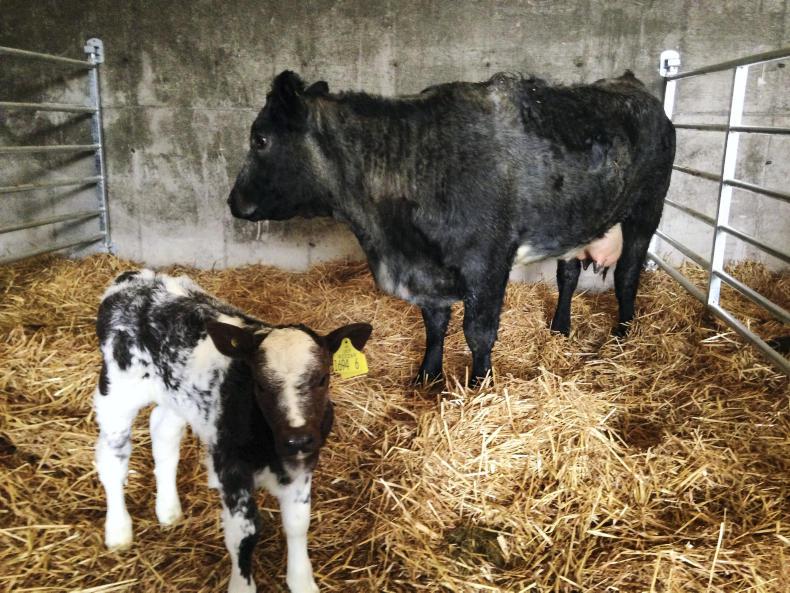Spring has yet to arrive for Irish farmers, which means it will be a late turnout for cattle this year. Where spring herds are busy with calving, pressure on housing space will be growing.
Feed reserves are also under pressure and while dry cows can have silage restricted, or be offered a lower-quality forage, calved cows need to be managed differently.
Outlined are five tips to help manage cows and calves while they remain housed, to help improve milk production, cow condition and fertility, as well as calf health.
1.Feed better-quality silage and concentrates
With calved cows you will should ideally offer them high-quality silage to support milk production and maintain body condition. However, with limited silage reserves after a long winter, it is likely that most farms have finished feeding their quality silage.
Feeding low-quality, high-fibre silage will slow digestion and reduce forage intakes. Therefore, cows will be taking in less energy, unless properly supplemented with concentrates.
With average- to good-quality silage (66 to 70 DMD) feed 2kg/day of a 16% ration, increasing to 3kg for silage of average quality (64 to 66 DMD) and 4kg/day for silage which is of below-average quality.
Concentrates will also provide minerals to cows on lower-quality forage, but provison of extra lick buckets is advisable.
Where silage is limited, every 1kg of concentrate can reduce silage intake by 4kg to 5kg (fresh weight), depending on quality.
However, cows need fibre in the diet to maintain rumen function, so make sure that at least 50% of their diet is in the form of silage or haylage.
2. Make full use of calf creeps
Make the most out of calf creeps by locking calves away from cows during the daytime and overnight.
Restricting calves from suckling cows will reduce the cow’s silage intake by as much as 20%, which could be a saving of up to 10kg/day (fresh weight) of valuable fodder.
Restricting suckling will not impact negatively on calf growth. Allowing the calf to suck the cow for a period of one to two hours in the morning and evening will maintain calf performance.
Also, offer calves a small quantity of concentrate and fodder while in the calf creep. Cow fertility will be improved through restricted suckling by coming back into heat faster and showing stronger heats.
3. Keeping bedding clean
Where young calves are housed they need a clean, dry bed to lie on. Keeping straw bedding clean and dry is paramount in reducing the risk of disease, especially as calving progresses and stocking density in sheds increases.
As a rule of thumb, to determine if a straw bed is okay for calves, you should be able to kneel on the bedding without getting your knees wet. If not, more straw is required.
Where cows and calves are housed in sheds with slatted and bedded floors, pen the cows on slats during the day to save on bedding.
4. Calf health
Make sure calves have been been throughly licked and suckling the cow before moving to larger, loose pens. Calf navals should also be treated with iodine or an antibiotic spray to reduce the transmission of disease from bedding. Hopefully, calves will have been vaccinated for scour and received adequate colostrum to build up immunity to the causes of such disease. However, vaccination is just one step in disease prevention.
Hygiene in sheds is also important.Clean bedding will improve calf health. However, the disease risk to calf health increases as more cows calve and numbers in sheds grow.
Clean out bedding as often as possible and spread hydrated lime in sheds to reduce the build-up of pathogens.
As calving progresses, calving hygiene will become even more important as newborn calves have zero immunity, but will be exposed to several pathogens at birth.
Take the time to ensure calves born halfway through the calving period get enough colostrum to give them a higher chance of avoiding scours.
Respiratory vaccines may be advisable if the farm has a history of IBR or pneumonia, and young calves are in the same air-space as older, bought-in cattle.
Giving the first shot of a respiratory vaccine around two weeks of age can greatly reduce the risk of a pneumonia outbreak.
Improving airflow is also a good idea in sheds with younger cattle, but make sure you do not create a draught in calf houses.
5. Fresh water
Calved cows have a high requirement for water, especially when they are on drier silage and concentrates. Keep drinking troughs clean so that cows are getting fresh water.
https://www.farmersjournal.ie/dealing-with-the-weather-colostrum-and-sos-355130
https://www.farmersjournal.ie/watch-grazing-underway-on-co-down-better-farm-354576






 This is a subscriber-only article
This is a subscriber-only article












SHARING OPTIONS: